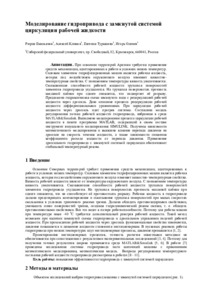Improving the efficiency of a hydraulic drive with a closed-loop hydraulic circuit
URI (для ссылок/цитирований):
https://iopscience.iop.org/article/10.1088/1742-6596/1515/4/042078https://elib.sfu-kras.ru/handle/2311/142637
Автор:
Оленев, Игорь Борисович
Емельянов, Рюрик Тимофеевич
Климов, Алексей Сергеевич
Кравцов, Константин Сергеевич
Турышева, Евгения Сергеевна
Коллективный автор:
Инженерно-строительный институт
Кафедра инженерных систем зданий и сооружений
Дата:
2020-05Журнал:
Journal of Physics: Conference SerieКвартиль журнала в Scopus:
Q3Квартиль журнала в Web of Science:
без квартиляБиблиографическое описание:
Оленев, Игорь Борисович. Improving the efficiency of a hydraulic drive with a closed-loop hydraulic circuit [Текст] / Игорь Борисович Оленев, Рюрик Тимофеевич Емельянов, Алексей Сергеевич Климов, Константин Сергеевич Кравцов, Евгения Сергеевна Турышева // Journal of Physics: Conference Serie. — 2020. — Т. 1515 (№ 4). — С. 042078Аннотация:
Abstract. While developing the Arctic territories, the use of mechanical equipment, adapted to work at low temperatures, is required. The power element of hydraulic machines is a hydraulic fluid, which, under different ambient conditions, changes the viscosity-temperature properties. With decreasing temperature, the viscosity increases. The hydraulic fluid lubricity of the rubbing surfaces of the hydraulic drive elements is declining. On rubbing surfaces, the oil film strength decreases, which leads to its rupture. A hydraulic circuit of the hydraulic drive is proposed, containing an additional adjustable throttle. When throttling the working fluid, the thermal energy releases. The process of throttling the working fluid is described by differential equations. To simulate the proposed system, a dynamic closed-loop hydraulic model was compiled using MATLAB&Simulink. Modeling the hydraulic drive made it possible to obtain the time dependences of the working fluid pressure as it leaves the throttle. The obtained dependences by mathematical modeling made it possible to determine the effect of the differential pressure on the throttle on the fluid flow rate, as well as the dependence of the decrease in the liquid flow coefficient on the differential pressure. The use of a throttle hydraulic actuator with a closedloop hydraulic circuit ensures stable temperature conditions.

